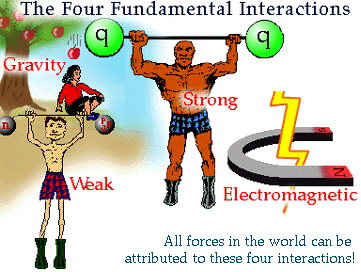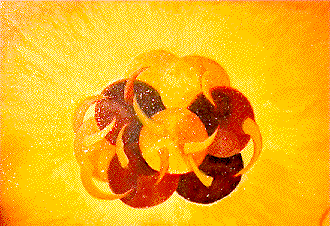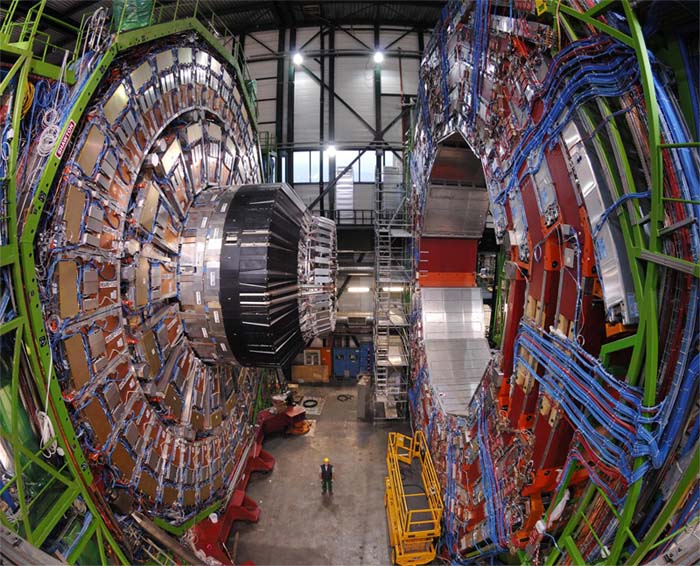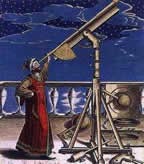Modern physics
Key points: Four fundamental forces;
fundamental particles; matter and antimatter
| There are four fundamental forces - they account for all forces known
to physics. We have already met three of them:
1.)
Gravitational (very, very weak)
2.) Electromagnetic (moderate)
3.) Nuclear (very strong)
In addition, there is 4.) the "weak"
nuclear force that is required to explain some nuclear reactions. (illustration
from CERN) |
 |
Although gravity is very, very weak, it has the advantage that it acts at long
range, and that there is only one sign for the force - unlike electric charges, there are
no plus and minus gravity charges to cancel each other out. Thus, gravity is the dominant
force over distances of a few kilometers and greater.
The electric force is an inverse r squared force, just like gravity, and it is
much stronger. However, it is canceled out over large distances by the existence of plus
and minus charges - if there is enough charge of one sign to exert a long-range force, the
first thing it does is attract particles with the opposite charge, and they cancel much of
the force. Nonetheless, it is generally dominant over distances from the separation of the
proton and electron in an atom, about 10-13 kilometers = 10-10 meters, up to a few kilometers.
| The nuclear forces are short range, and act over the size of an
atomic nucleus only, about 10-13 meters. To the right is an artist's concept of
the strong nuclear force bonding the protons and neutrons in an atomic nucleus. (from
Judy Racz, http://home.vicnet.net.au/~richard/racz.htm) |
 |
Nuclear Particles
Modern physics has discovered far more particles than just the photon, proton,
neutron, and electron that we have discussed We will learn a bit more about quarks and the early Universe soon.
They are thought to be the basic building blocks for all matter
We will learn a bit more about quarks and the early Universe soon.
They are thought to be the basic building blocks for all matter There are six of them, and
physicists with some measure of whimsy have named them up, down, top, bottom, strange, and
charm. They have fractional electric charge (either +2/3 or -1/3), and in various
combinations account for some 200 separate larger particles. They are held in these
various combinations by the strong nuclear force, and in fact are highly unstable unless
confined this way. As an example, the proton is made of two "up" quarks, each
with charge of +2/3, and one "down" quark, with a charge of -1/3. Neutrons are
one "up" quark and two "down" quarks. If quarks are so unstable, how to we
know they are real? Well, their existence was first predicted by the standard
model, which has had many other successes in explaining the
behavior of nuclear particles, in a simple and unifying way. Although these
concepts seem very abstract, the predictive power of the standard model is very
convincing in a scientific sense.
There are six of them, and
physicists with some measure of whimsy have named them up, down, top, bottom, strange, and
charm. They have fractional electric charge (either +2/3 or -1/3), and in various
combinations account for some 200 separate larger particles. They are held in these
various combinations by the strong nuclear force, and in fact are highly unstable unless
confined this way. As an example, the proton is made of two "up" quarks, each
with charge of +2/3, and one "down" quark, with a charge of -1/3. Neutrons are
one "up" quark and two "down" quarks. If quarks are so unstable, how to we
know they are real? Well, their existence was first predicted by the standard
model, which has had many other successes in explaining the
behavior of nuclear particles, in a simple and unifying way. Although these
concepts seem very abstract, the predictive power of the standard model is very
convincing in a scientific sense.
Another particle is the neutrino. It is the product of certain reactions we will
learn about when we study the energy output of the sun, for example. Neutrinos have little
or no mass and hence travel at virtually the speed of light. They almost do not react at
all with other forms of matter, so they can escape from the very core of the sun and make
it to earth.
The electromagnetic, nuclear, and weak nuclear forces are all
described by the "standard model" of particle physics, but this theory
does not account for the behavior of gravity.
Higgs Boson
 |
As powerful as the standard model is, there are some
deficiencies. The most obvious (after its failure to include gravity) until
recently was that it could only account for the masses
of the elementary particles if another particle existed, with a huge mass of
133 times that of the proton and a very short lifetime before it decays.
This "Higgs Boson" was theorized to exist in the 1960s by Peter Higgs and
others to solve the mass problem. Higgs proposed that an energy field
permeates the Universe, and just as the photon carries the effects of the
electromagnetic force, the Higgs boson carries the effects of this field,
and converts energy to mass, thus providing the route to the existence of all
mass in the Universe. Physicists searched for this particle for many years
and had built the Large Hadron Collider (LHC) specifically to find it. In July, 2012,
they announced that they had found evidence for it; further evidence for its
existence was announced March 14, 2013. The Higgs Boson is sometimes
called "the God particle," but many physicists find that name overly
sensational and object to it.
Because the Higgs Boson is so massive, it took huge
particle energies to produce it and a correspondingly huge machine (to left -
note the human on the floor in the lower center) to create these energies
and control them. The ATLAS detector part of the LHS, from http://news.discovery.com/space/higgs-boson-kinda-sorta-discovered-120704.htm |
Matter and Antimatter
Einstein's E = mc2 implies that it might be possible for nuclear
particles to get converted to energy, and energy to nuclear particles. And so it is.
However, understanding how it happens leads to a new perspective on matter. It shows that
there is a whole zoo of nuclear particles just like the ones we have discussed except
reversed in key aspects, such as electric charge. Thus, there is an anti-proton, with the
same mass as a proton but negative charge. There is an anti-electron (sometimes called a
positron), with the same mass as an electron but a positive charge, and so forth.
When a particle encounters its anti-particle, they
annihilate each other and the energy predicted by Einstein's equation emerges as two gamma
rays. Similarly, if gamma rays come together in just the right way, they can disappear
with the creation of a particle and its anti-particle. (figures
from J. Schombert, http://zebu.uoregon.edu/~js/ast123/lectures/lec18.html) |
 |
 |

Bright star Alcyone from the inlaid star map at Hoover Dam,(G.
Rieke) |

|

J. Hevelius at the telescope |
Click to return to syllabus |
| Click to return to Other Stars |
hypertext  G. H. & M. J. Rieke G. H. & M. J. Rieke |
Click to go to Observatories |







